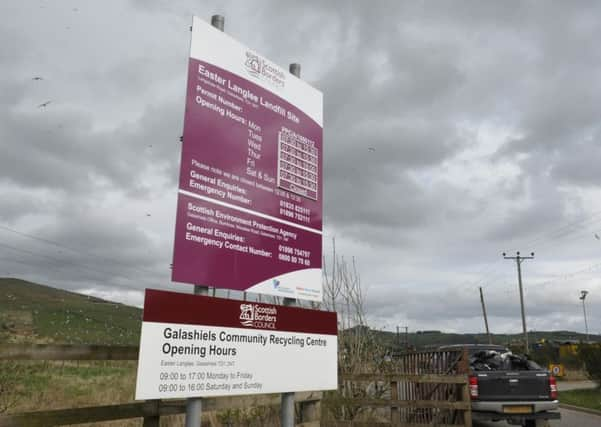Greenhouse gas emissions from Galashiels landfill site up by more than a quarter


Data released by the Scottish Environment Protection Agency reveals that 451,000kg of methane were released into the atmosphere by rotting rubbish at Easter Langlee.
That’s 27% up on the 356,000kg produced in 2016 and more than twice the 197,000kg generated in 20111.
The reporting threshold for methane is 10,000kg a year.
Advertisement
Hide AdAdvertisement
Hide AdThe latest statistics for CFCs (chlorofluorocarbons) and HCFCs (hydrochlorofluorocarbons) at Easter Langlee also show alarming increases, being up 39.7% and 25% respectively.
In the case of those two pollutants, the reporting threshold is 1kg, but the Borders landfill site generated 38.3kg of CFCs, up from 27.4kg in 2016, and 26.5kg of HCFCs, up from 21.4kg the year before.
Waste management emissions across Scotland as a whole have been going in the opposite direction to those in the Borders, falling by 4.9% year on year in 2016, those being the latest national figures available.
The Scottish Government claims that decrease is largely due to progressive introduction of methane capture and oxidisation systems within landfill management. Between 1990 and 2016, such emissions dropped by 72.8%.
Advertisement
Hide AdAdvertisement
Hide AdBetween 2002 and 2017, though figures are not available for 2003, Easter Langlee produced 13,867,000kg of methane.
Research showing that a dairy cow will generate 110.7kg of methane annually and a beef cow 50.5kg, means the Borders tip’s emissions of the gas last year were equivalent to the output of a herd of 4,074 of the former or 8,930 of the latter.
So far as CFCs and HCFCs are concerned, the Borders’ landfill emissions show no sign of falling, with CFCs being well up on the 2013 level of 27.5kg and HCFCs remaining static.
In April 2015, Persimmon Homes had to call a temporary halt to building at its Melrose Gait housing development near the Easter Langlee tip because of elevated levels of methane gas and carbon dioxide being recorded there.
Advertisement
Hide AdAdvertisement
Hide AdThe UK’s biggest man-made source of methane is rotting rubbish at landfills sites such as Easter Langlee.
An agency spokesperson said: “On a local scale, build-up of methane poses an explosion hazard which can result in evacuation of areas over old landfills or mines.
“The main impact of methane is on a global scale as a greenhouse gas. Although levels of methane in the environment are relatively low, its high global warming potential ranks it amongst the worst of the greenhouse gases.
“At a global level, releases of CFCs have serious environmental consequences. Their long lifetimes in the atmosphere mean that some end up in the higher atmosphere, where they can destroy the ozone layer, thus reducing the protection it offers the earth from the sun’s harmful ultraviolet rays.
Advertisement
Hide AdAdvertisement
Hide Ad“CFCs also contribute to global warming through the greenhouse effect. Although the amounts emitted are relatively small, they have a powerful warming effect.
“Although not as stable and therefore not so persistent in the atmosphere as CFCs, HCFCs can still end up in the stratosphere, where they can destroy the ozone layer.”
The council was unavailable for comment.